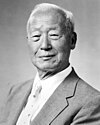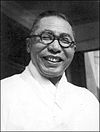
Syngman Rhee was a South Korean politician who served as the first president of South Korea from 1948 to 1960. Rhee is also known by his art name Unam. Rhee was also the first and last president of the Provisional Government of the Republic of Korea from 1919 to his impeachment in 1925 and from 1947 to 1948. As president of South Korea, Rhee's government was characterised by authoritarianism, limited economic development, and in the late 1950s growing political instability and public opposition.

The Cairo Declaration was the outcome of the Cairo Conference in Cairo, Egypt, on 27 November 1943. President Franklin Roosevelt of the United States, Prime Minister Winston Churchill of the United Kingdom, and Generalissimo Chiang Kai-shek of the Republic of China were present. The declaration developed ideas from the 1941 Atlantic Charter, which was issued by the Allies of World War II to set goals for the post-war order. The Cairo Communiqué was broadcast through radio on 1 December 1943.

The division of Korea began with the 15 August 1945 official announcement of the surrender of Japan, thus ending the Pacific Theater of World War II. During the war, the Allied leaders had already been considering the question of Korea's future following Japan's eventual surrender in the war. The leaders reached an understanding that Korea would be liberated from Japan but would be placed under an international trusteeship until the Koreans would be deemed ready for self-rule. In the last days of the war, the United States proposed dividing the Korean peninsula into two occupation zones with the 38th parallel as the dividing line. The Soviets accepted their proposal and agreed to divide Korea.

The March 1st Movement, also known as the Sam-il (3-1) Movement (Korean: 3.1운동), was a significant protest movement in early 1919 by Korean people that called for independence from Imperial Japan and a stop to the forced assimilation into Japanese culture. It is also sometimes referred to as the Man-se Demonstrations. It is remembered as one of the earliest and largest protest movements for Korean independence, and remembered as a catalyst for future independence activities. Thirty-three Korean cultural and religious leaders issued a proclamation, supported by thousands of students and civilians in Seoul. There were over 1,000 demonstrations in many other cities. These were brutally suppressed, with Korean historian Park Eun-sik reporting about 7,500 killed and 16,000 wounded, and 46,000 arrested.
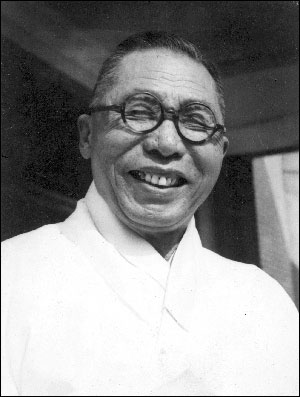
Kim Ku, also known by his art name Paekpŏm, was a Korean politician. He was a leader of the Korean independence movement against the Empire of Japan, head of the Korean Provisional Government for multiple terms, creator of the Korean Liberation Army, and a Korean reunification activist after 1945. Kim is revered in South Korea, where he is widely considered one of the greatest figures in Korean history.

The Korean Provisional Government (KPG), formally the Provisional Government of the Republic of Korea, was a Korean government in exile based in China during the Japanese occupation of Korea.
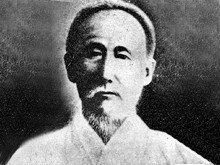
Park Eunsik was a Korean historian and the second President of the Provisional Government of the Republic of Korea in Shanghai during part of 1925. Soon after the impeachment of Syngman Rhee from the presidency, Park was elected the president, but he soon died from illness while in office. Park was succeeded by Yi Sang-ryong as the president.

The Syngman Rhee Line was a marine boundary line established by South Korean President Syngman Rhee in his "Peace Line" declaration of January 18, 1952, establishing a wide area of maritime sovereignty, beyond internationally accepted territorial waters, around the entire Korean Peninsula. This included placing the Liancourt Rocks (Dokdo/Takeshima) in South Korean territory. The line was abolished in 1965 with the signing of a Japanese–South Korean fishing agreement.
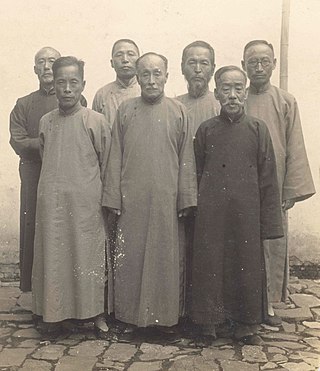
Yi Dongnyeong was a Korean independence activist. He served as the fourth (1926), seventh (1927–1930), eighth (1930–1933), tenth (1935–1939), and eleventh (1939–1940) President of the Provisional Government of the Republic of Korea in exile in Shanghai, China.

The Korean Liberation Army, also known as the Korean Restoration Army, was the armed forces of the Provisional Government of the Republic of Korea. It was established on September 17, 1940, in Chongqing, Republic of China, with significant financial and personnel support from the Kuomintang. It participated in various battles and intelligence activities against the Japanese, including alongside the British Army in India and with the United States in the Eagle Project. The group only reached several hundred personnel at its peak, and faced constant funding issues, infighting, and difficulty achieving recognition from global powers. The modern Republic of Korea Armed Forces and the Korean People's Army are widely considered to be the successor of the Korean Liberation Army.

Chang Myon was a South Korean statesman, educator, diplomat, journalist and social activist as well as a Roman Catholic youth activist. He was the only prime minister of the parliamentary Second Republic. In addition, during the First Republic he was the fourth and last vice president of South Korea. His art name was Unseok (운석). His English name was John Chang Myon.

Park Yong-man was a Korean nationalist and independence activist who, after spending time in prison for reformist activities, immigrated to the United States of America. There Park was involved in the establishment of various Korean nationalist organizations in Denver, Nebraska and Hawaii. Park also founded the Korean National Army Corps. Following the March 1st Movement in 1919, Park became involved with the military training of Korean nationalists in China, but may have also engaged in anti-communist activity. Park was assassinated in Beijing by a Korean communist.

Sin Ik-hui was a Korean independence activist and politician. He was Speaker of the National Assembly during President Syngman Rhee's first term and second term.

Lyuh Woon-hyung or Yo Un-hyung was a Korean politician who argued that Korean independence was essential to world peace, and a reunification activist who struggled for the independent reunification of Korea following its national division in 1945.
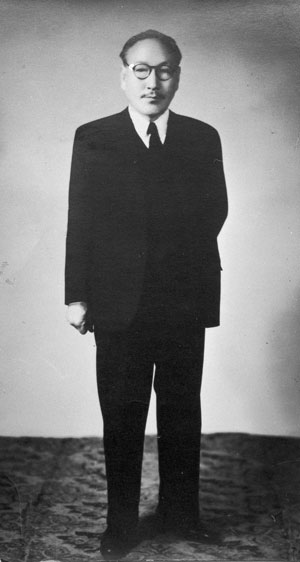
Jo So-ang was a Korean politician, educator, and Korean independence activist. He spent much of his career in exile in China, working in the Provisional Government of the Republic of Korea. After Korea gained its independence in 1945, he returned to Korea. He was a right-leaning politician who supported the Provisional Government over the various competing left-leaning organizations.
Events from the year 1948 in South Korea.
The Korean Patriotic Organization (Korean: 한인애국단) was a militant organization under the Korean Provisional Government (KPG) and founded in Shanghai, China in 1931. It aimed to assassinate military and government leaders of the Empire of Japan. The group also went by the name Ŭisaenggun.

Ilminism, frequently translated as the One-People Principle, One-People Doctrine, or Unidemism, was the political ideology of South Korea under its first President, Syngman Rhee. The Ilminist principle has been likened by contemporary scholars to the Nazi ideal of the Herrenvolk and was part of an effort to consolidate a united and obedient citizenry around Rhee's strong central leadership through appeals to ultranationalism and ethnic supremacy. In general, "Ilminists" often refers to pro-Syngman Rhee (groups).
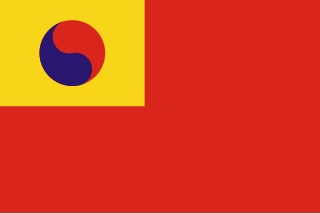
The Korean National Association, also known as All Korea Korean National Association, was a political organization established on February 1, 1909, to fight Japan's colonial policies and occupation in Korea. It was founded in San Francisco by the intellectual scholar and Korean Independence activist Ahn Changho, and represented the interests of Koreans in the United States, Russian Far East, and Manchuria during the Korean Independence Movement.
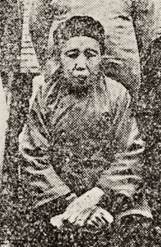
Kwak Nak-won was a Korean independence activist and the mother of Kim Ku. She joined her son in exile in the Republic of China and assisted him and her grandchildren in their resistance against the Empire of Japan. She, along with her son, are revered in South Korea, where she is seen as a paragon of Korean motherhood.
